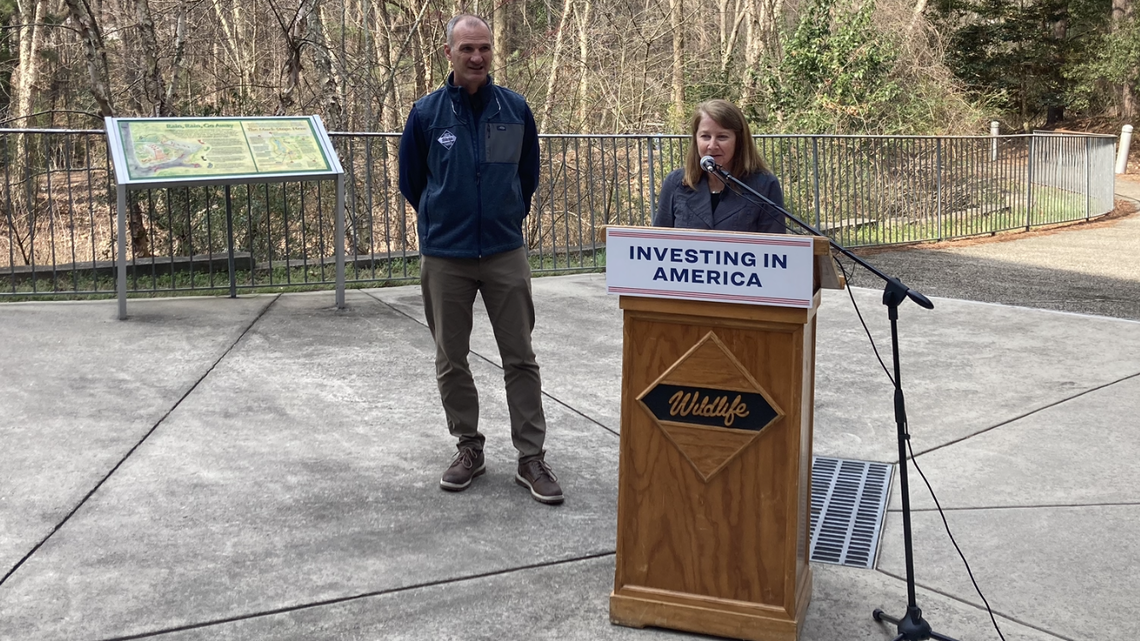Here’s how NC will use its share of the ‘America the Beautiful’ US conservation grant

- Oops!Something went wrong.Please try again later.
As part of a nationwide effort to restore natural habitats, the U.S. Department of the Interior and partner agencies are making $119 million available to fund conservation projects, one of the agency’s leaders announced in Raleigh.
Those efforts will be part of the America the Beautiful Challenge, a partnership that pulls together public and private funds to support large-scale projects.
“At the heart of America the Beautiful are collaboration, partnerships, a commitment to follow the science wherever it leads us, and a commitment to honoring tribal sovereignty and indigenous knowledge at every turn,” Laura Daniel-Davis, the acting deputy secretary of the Interior, said in Raleigh Monday.
The N.C. Wildlife Resources Commission is working on a pair of those projects already: an effort to re-establish wetlands and restore an Atlantic white cedar in Duplin County, and another to restore longleaf pine habitat across Eastern North Carolina.
“These two projects are great examples of the funds that we are receiving — the federal funds that we are receiving through these grants — to flourish those habitats, to restore damaged habitats that we’ve had in our state so our species will survive, and then the public can enjoy them,” said Cameron Ingram, executive director of the Wildlife Resources Commission.
The two North Carolina projects were among 74 funded at a total of $153.4 million in 2023, the challenge’s second year. That followed $141.7 million in grants nationwide in the challenge’s first year.
The grants cover four years of work.
In the $1.88 million Atlantic white cedar project, the Wildlife Resources Commission is working on the 7,500-acre Angola Game Land to replace recently cleared pine stands with the Atlantic white cedar, a tree that is considered a globally threatened ecosystem because so many were cut down. The Atlantic white cedar grows in wetlands that are near sea level, leaving existing trees vulnerable to sea level rise.
N.C. Wildlife Resources Commission officials will plant 1,383 acres of the trees. They will also raise eight miles of low-lying roads and install water control devices that re-wet peatland that was ditched and drained for agricultural use.
Ingram said the project will help make the land more resilient against flooding by restoring wetlands that act as a sponge against rainfall while also protecting against wildfires. It also will create habitat for threatened species like the timber rattlesnake and endangered species like the red-cockaded woodpecker.
In North Carolina’s other America the Beautiful Challenge project, the Wildlife Resources Commission, the U.S. Department of Defense and other wildlife agencies across the Southeast will restore longleaf pine habitat. Of the $2.69 million grant, the commission will spend $625,000 in North Carolina increasing the crews that conduct prescribed burns on private lands.
That will allow the state to conduct burns on an additional 750 acres. Fire is a vital part of the life cycle of the long-leaf pine, with the tree adapted to protect itself from fire in the grass stage and quickly grow after a blaze.
Prescribed burns also reduce the risk of wildfires by clearing brush that has built up over time.
The commission plans to use grant funding to plant 200 acres of native plants that are friendly to bees and other pollinators in longleaf pine forests. In the final aspect of the project, the commission will evaluate whether 800 crossings under roadways are friendly to aquatic species like the gopher frog and broadtail madtom.
After taking office in 2021, President Joe Biden set a goal of conserving and restoring 30% of the nation’s lands and waters by 2030.
The America the Beautiful Challenge is part of that. The challenge draws funding from the Department of the Interior, U.S. Department of Defense, Native Americans in Philanthropy and other organizations to fund large-scale conservation projects that reconnect wildlife corridors and improve resilience for nearby communities.
The National Fish and Wildlife Foundation administers the program, and the new grant application cycle will close on April 4.
“These investments that we’re going to be able to make are going to continue to be transformational for communities across America,” Daniel-Davis said.
This story was produced with financial support from the Hartfield Foundation and Green South Foundation, in partnership with Journalism Funding Partners, as part of an independent journalism fellowship program. The N&O maintains full editorial control of the work. If you would like to help support local journalism, please consider signing up for a digital subscription, which you can do here.

